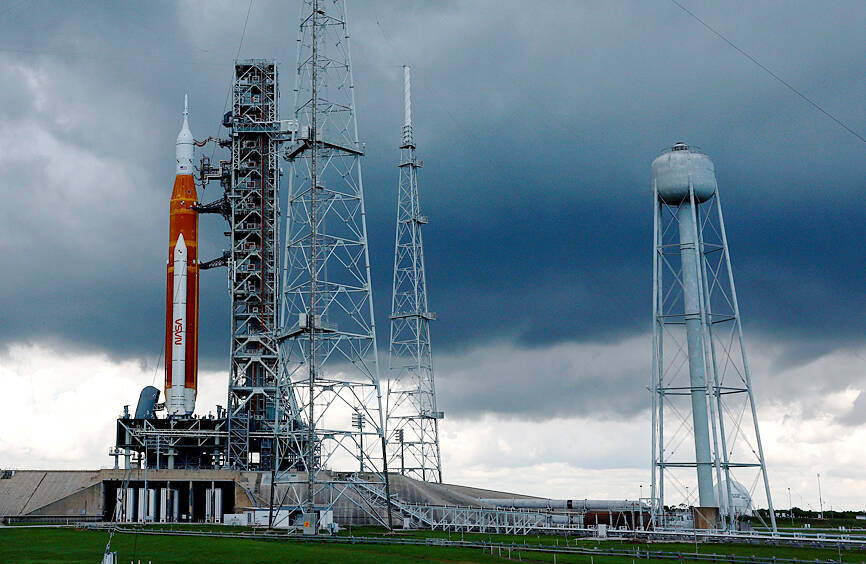NASA is about to take the first step on its journey to return people to the moon by the end of the decade. If all goes well, a massive uncrewed rocket will lift off from the Kennedy Space Center tomorrow morning, then orbit the moon before it returns to Earth 42 days later.
The Artemis I mission marks a critical moment for NASA and the space industry. The Artemis program, named for the twin sister of the god Apollo in Greek mythology, aims to land the first woman and the first person of color on the moon as early as 2025.
Among the critical components of the mission are a Boeing Co rocket called Space Launch System, and an Orion crew capsule made by Lockheed Martin Corp.

Photo: AFP
The stakes are high for NASA and its corporate contractors after a decade of delays and cost overruns. It marks the first time since the end of the space shuttle program that NASA has debuted a new flagship vehicle and system geared toward human spaceflight.
After the shuttle was retired, NASA relied on Russia’s Soyuz rocket to get humans to and from the International Space Station and, more recently, has turned to SpaceX’s Falcon 9 rocket and Dragon crew capsule.
The return of NASA to moon missions has followed a long and tortuous path on Earth. Multiple administrations proposed ambitious human spaceflight programs after the end of the Apollo program of the 1960s and 1970s, only to fall victim to budgetary concerns and high-profile setbacks.
The Space Launch System has been in development for about a decade, slowed by myriad delays and cost overruns. More than five years behind schedule, the rocket has seen its cost soar from an original US$7 billion to about US$23 billion, an estimate by the Planetary Society showed.
Multiple audits of NASA’s main contractor, Boeing , have criticized the company for its management of the system, and have highlighted flaws throughout the vehicle’s construction and testing.
NASA and Boeing are tempering expectations ahead of the launch, saying that Artemis I is a test of a highly complex system.
“It’s not without risk,” NASA associate administrator Jim Free said. “We have analyzed the risk as best we can, and we’ve mitigated, also, as best we can.”
Even a successful test flight might not satisfy those who have criticized the Space Launch System’s high price tag and inefficiency.
SpaceX’s planned Starship spacecraft might prove even more powerful than the Boeing system, as well as cheaper to develop and launch when it becomes operational. Additionally, Starship is designed to be fully reusable.
It could be years before Starship is ready to carry humans to deep space, but NASA has contracted SpaceX to develop Starship as a human lunar landing system as part of Artemis. So, the Space Launch System and Starship could be seen as in competition with one another, but they could work together to help return astronauts to the moon.

Former Nicaraguan president Violeta Chamorro, who brought peace to Nicaragua after years of war and was the first woman elected president in the Americas, died on Saturday at the age of 95, her family said. Chamorro, who ruled the poor Central American country from 1990 to 1997, “died in peace, surrounded by the affection and love of her children,” said a statement issued by her four children. As president, Chamorro ended a civil war that had raged for much of the 1980s as US-backed rebels known as the “Contras” fought the leftist Sandinista government. That conflict made Nicaragua one of

COMPETITION: The US and Russia make up about 90 percent of the world stockpile and are adding new versions, while China’s nuclear force is steadily rising, SIPRI said Most of the world’s nuclear-armed states continued to modernize their arsenals last year, setting the stage for a new nuclear arms race, the Stockholm International Peace Research Institute (SIPRI) said yesterday. Nuclear powers including the US and Russia — which account for about 90 percent of the world’s stockpile — had spent time last year “upgrading existing weapons and adding newer versions,” researchers said. Since the end of the Cold War, old warheads have generally been dismantled quicker than new ones have been deployed, resulting in a decrease in the overall number of warheads. However, SIPRI said that the trend was likely

NUCLEAR WARNING: Elites are carelessly fomenting fear and tensions between nuclear powers, perhaps because they have access to shelters, Tulsi Gabbard said After a trip to Hiroshima, US Director of National Intelligence Tulsi Gabbard on Tuesday warned that “warmongers” were pushing the world to the brink of nuclear war. Gabbard did not specify her concerns. Gabbard posted on social media a video of grisly footage from the world’s first nuclear attack and of her staring reflectively at the Hiroshima Peace Memorial. On Aug. 6, 1945, the US obliterated Hiroshima, killing 140,000 people in the explosion and by the end of the year from the uranium bomb’s effects. Three days later, a US plane dropped a plutonium bomb on Nagasaki, leaving abut 74,000 people dead by the

Indian Prime Minister Narendra Modi is to visit Canada next week, his first since relations plummeted after the assassination of a Canadian Sikh separatist in Vancouver, triggering diplomatic expulsions and hitting trade. Analysts hope it is a step toward repairing ties that soured in 2023, after then-Canadian prime minister Justin Trudeau pointed the finger at New Delhi’s involvement in murdering Hardeep Singh Nijjar, claims India furiously denied. An invitation extended by new Canadian Prime Minister Mark Carney to Modi to attend the G7 leaders summit in Canada offers a chance to “reset” relations, former Indian diplomat Harsh Vardhan Shringla said. “This is a